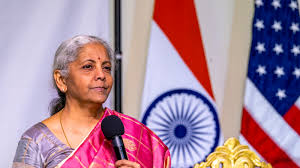
Fintechs Urged to View Agriculture and Rural India as Emerging Markets, Not Mere Social Duty: FM Sitharaman

 :
| Updated On: 19-Jun-2025 @ 2:40 pm
:
| Updated On: 19-Jun-2025 @ 2:40 pmSHARE
At the Digital Payments Awards 2025, Finance Minister Nirmala Sitharaman emphasized the transformative role of fintech companies in India’s agricultural and rural sectors. Addressing a gathering hosted by the Department of Financial Services under the Ministry of Finance, she urged fintech firms to consider rural India and agriculture not just as a social responsibility but as a significant business opportunity to create new markets. Highlighting the revival of demand in rural areas, she drew parallels with the FMCG sector and called for increased participation from fintech players to bridge market gaps and empower farmers.
Sitharaman stressed the need for innovative solutions to better connect rural areas to broader markets and improve access to financial services. She underscored the role fintechs can play in enabling access to credit for Micro, Small, and Medium Enterprises (MSMEs), which form a crucial backbone of India’s economy. With India’s fintech adoption rate standing at an impressive 87%, compared to the global average of 67%, the Finance Minister highlighted that India is leading the way in digital financial innovation, even outpacing several advanced economies.
During her address, Sitharaman acknowledged the achievements of various public and private sector banks and fintech companies. Award winners included Punjab National Bank, Bank of Baroda, and UCO Bank among public sector banks; HDFC Bank, City Union Bank, and IDFC FIRST Bank among private sector banks; and Equitas Small Finance Bank and India Post Payments Bank in the small finance category. In fintech, WhatsApp Meta, Navi, and Mobikwik shared top honors in the third-party app providers category, while PhonePe, Paytm, and Google Pay won top places in offline digital payment infrastructure.
Applauding India’s “light-touch regulation, heavy encouragement” policy, Sitharaman noted that while India has made significant strides, more needs to be done to bring a larger segment of the population under financial inclusion. She called for fintech companies to “push the boundaries” to support the government’s ambition of making India a developed nation by 2047. Since 2014, nearly ₹44 lakh crore has been transferred through Direct Benefit Transfers (DBTs), resulting in savings of around ₹3.48 lakh crore.
Looking ahead, Sitharaman advocated for broader financial inclusion through the use of regional languages and voice-enabled services. She emphasized the potential of account aggregators, noting a surge in entities on the platform—from just 24 three years ago to nearly 700 by March 2025. She also flagged the importance of digital literacy and cybersecurity to prevent people from falling victim to fraud or exploitation by deceptive digital entities. Fintech firms, she said, must constantly develop solutions to meet emerging challenges.
M Nagaraju, Secretary of the Department of Financial Services, echoed Sitharaman’s vision, noting the success of the Unified Payments Interface (UPI), which is now operational in seven countries including France, Singapore, and the UAE. He outlined future priorities: expanding digital payment usage, boosting cybersecurity, preventing fraud, and ensuring inclusivity in financial services.
Sitharaman concluded by urging India’s fintech sector to go global, turning domestic innovations into international public goods that benefit other emerging economies. With the Indian fintech market projected to exceed $400 billion by 2028-29, she said its most promising chapters are yet to be written.
Contact Us
House. No. : 163, Second Floor Haridev Rd, near Puberun Path, Hatigaon,Guwahati, Assam 781038.
E-mail : assaminkcontact@gmail.com
Contact : +91 8811887662
Enquiry
×
Reporter Login
×